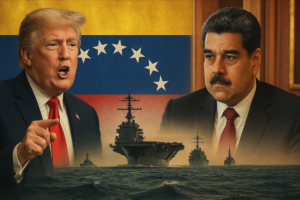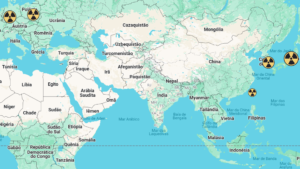- USTRANSCOM takes care of the military logistics of the American armed forces and, in times of peace, has general transportation functions;
- In an armed conflict, logistics is essential for the movement of troops, weapons, ammunition and other vital resources such as food and fuel;
- Logistics appears to be one of Russia’s biggest weaknesses in its invasion of Ukraine, as they expected a quick conflict.
It is nothing new that the United States‘ weapons capacity is exorbitant. The country has invested and is constantly investing in the evolution of its military equipment and strategies. Modernized aircraft, nuclear weapons, missiles, trained troops. The North American country has more than half a million active soldiers in service.
However, the country’s forces are not limited to its equipment, technologies, tactics and the amount of weapons in numbers, but also its logistical capacity to transport all this power to anywhere in the world, at any time, from any initial location. .
This logistical role is intended for USTRANSCOM.

What is USTRANSCOM?
Created during the Cold War period, in 1987, the United States Transportation Command, or USTRANSCOM, is headquartered at Scott Air Force Base, in Illinois.
With the American history of being involved in conflicts around the world, such as the Second World War, the Korean War and the Vietnam War, there was a need to transport all of its military equipment so that, combined with its tactics and strategies, could emerge victorious.
Thus, in 1987, then President Ronald Reagan declared that the Secretary of Defense would create a Unified Transport Command, which gave rise to what is known today as USTRANSCOM.
Although the project seemed to be a solution to the country’s logistical problems, as it involved valuable military equipment, the document was still very restrictive and limited. In other words, military operations continued to take place as before its creation.
Only when the United States and its allies invaded Iraq in the Gulf War was it possible to test, in practice, the functionality of the United States Transportation Command. In this way, it was possible to analyze how USTRANSCOM would work both in times of peace and in times of war.
Thus, in February 1992, the current Secretary of Defense, Dick Cheney, declared that the main role of USTRANSCOM was to provide sea, land and air transportation to the Department of Defense, distributing its forces in three ways as in the Nuclear Triad – through the air, land and sea – in any season, be it peace or war. Then, USTRANSCOM began to act:
- In aerial transport and refueling: transporting people in critical condition to aid points or taking resupply forces and resources from one point to another, over any distance and at any time;
- On the surface: providing a transport infrastructure that allows the movement of troops and military forces;
- In maritime transport: transporting around 90% of the United States Department of Defense’s equipment. Maritime transportation is a priority for USTRANSCOM.
What are USTRANSCOM’s means of transportation?
With changes in investments, budgets, exchange of military strategies and modernization of equipment, USTRANSCOM’s capabilities can vary greatly from year to year, as well as the means used.
However, each of the three commands, that is, air, land and sea, has its own transport equipment.
- In the air force, for example, the Air Mobility Command has planes such as the C-17 Globemaster III, C-5 Galaxy, C-130 Hercules, KC-135 Stratotanker and the KC-10 Extender, responsible for transporting people, resources, weapons and fuel;
- In the navy, USTRANSCOM uses state and commercial ships to transport its equipment, such as Fast Sealift and the US military command ship list, which contains about 130 ships, divided into eight categories/programs;
- The army distributes via surface. They are in 24 ports around the world and can transport around 3.7 million tons of medication in a year. Active, they have 10 thousand containers and 1,350 railway wagons.
Furthermore, USTRANSCOM is studying ways to use Elon Musk’s rocket company, Space X, as one of its allies in military logistics. However, William Hartung, a researcher at the Quincy Institute told The Intercept that he finds the idea unfeasible, considering that there is currently no need for space transportation and that, despite being an interesting idea in the imagination, it is not practical.
Why the logistical capacity of the armed forces is essential on the battlefield
In World War II, United States General Omar Bradley was known for being strict in planning. While explaining the difference between just talking and creating plans based on facts, Omar said that “amateurs talk about tactics, professionals talk about logistics.”
A nation does not become victorious with just a collection of tactics to defeat the enemy. It is necessary to be able to maintain offensive power with ammunition, food, water and specialized personnel, which are part of military logistics.
Even if a country has quality, state-of-the-art equipment, as well as well-structured tactics, if there are no logistics to keep these tactics working, it’s as if everything goes back to square one. The combat power will not last long unless it is a quick offensive.
Many experts consider that logistics is what determines the course of a conflict in the medium and long term. As highlighted by Freight Waves, it is crucial mainly because:
- Ammunition is needed to arm soldiers, who cannot wait long for supplies of something that is used constantly and on a large scale. Military personnel must always have everything essential on hand;
- Fuel transportation is essential to supply tanks, planes, ships and combat vehicles in general;
- Troops need to move safely, via ships, planes or helicopters;
- Real-time monitoring is necessary to monitor what is happening on and off the front line to make quick decisions and formulate new plans;
- Smart algorithms can help manage data and satellite communications to understand what troops need, creating a tactical advantage.
In short, there is no victory without consistent logistics.
The failure of Russian logistics in the invasion of Ukraine
Russia’s invasion of Ukraine presented problems from the beginning. The conflict, which the Russian country was betting would be quick, with its victory over Kiev in a few days, dragged on for much longer than expected, bringing logistical problems for Russia.
Considering that Russia expected a short conflict, according to several analysts, supply problems and shortages plague Moscow. Furthermore, the country also suffers from a lack of manpower and trained people, both for the battlefield and for logistics, as the number of casualties has become much higher than expected.
Troops and supplies are mostly moved by rail and, occasionally, rivers. However, in some places, where wet and muddy soil hinders the process, Russians have to opt for roads. As these routes need to be constant, the process of transporting weapons, food, supplies in general, doctors, engineers and cooks becomes complex.
Instead of establishing logistical posts throughout the territory, Moscow chose to make a rapid advance, causing a lot of damage to the country’s military strategy, such as intact tanks abandoned due to lack of fuel.
The war only reinforced how logistics, aligned directly with the battlefield and society, is one of the fundamental pillars of a well-consolidated defense in a long-term conflict that demands, in addition to strategy, the ability to remain constant.
The geopolitical importance of the United States’ exorbitant logistical capacity
Despite the problems faced and, naturally, USTRANSCOM is not perfect, it is still one of the great differences of the North American army.
Even though countries like China and Russia or the European Union also have very large military capabilities, in terms of logistics the United States is more advanced than any other nation in the world.
And the military strength of a country can also be measured by its logistical capacity, which makes its military abilities borderless and, consequently, increasing its power of political influence, as a country with greater military projection capacity has bargaining power and the imposition of its interests on the global stage.
In addition to using military power for its own benefit, a nation with consolidated logistics can support its allies almost anywhere in the world. The United States, for example, offers this help through NATO in Europe or with its alliances in Asia and the Pacific via QUAD or AUKUS.
A demonstration of how the US can act in smaller countries with its logistical power comes from the Philippines, which may end up requesting support if China decides to put into action its expansion plan in the South China Sea, which currently encompasses Philippine territory. This is all considering that the North American nation already has military bases there.
United States logistical operations also play a fundamental role in supplying and maintaining the country’s military bases around the world, which are able to play a containment role. For example, the US military presence in Okinawa or the Philippines, which are relatively close to Taiwan, can be pointed out as one of the main reasons why China remains cautious when considering an invasion of Taiwanese territory.
In this way, the US expeditionary capacity, that is, its strength to intervene and influence militarily anywhere in the world, is only reinforced. Making global geopolitics, in a way, constantly influenced in part by the USA.






Be First to Comment